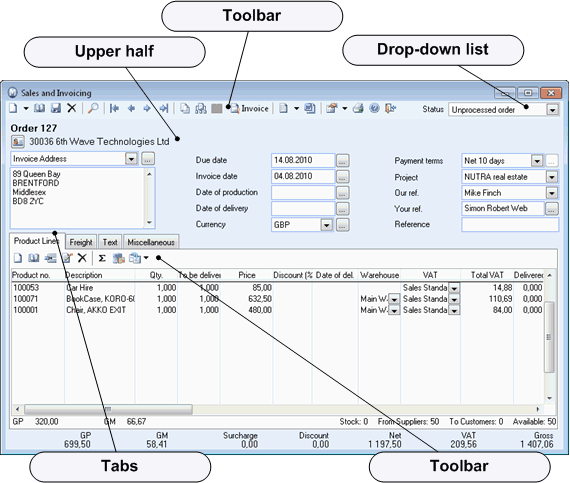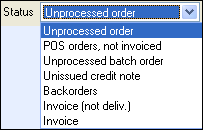Screens in the Program
When opening a module, a new screen for this module will also open. The windows in the program are built on the same template for all modules. This makes it easier for you as a user to become familiar with the different functions available without needing to establish your bearings from scratch every time you enter a new window.

The toolbar
At the top of the screen you will find the toolbar. Generally, this contains buttons for creating new items, deleting items, duplication etc., buttons for going back and forward within the register, as well as buttons for functions that go hand in hand with the processing of items. If this involves a process over several steps, the buttons are usually placed from left to right and activated according to how far you are within the process. An example of this is the Purchase screen, where the 'Update ledger' function will not be available until you have registered the receipt of the goods. You can read more in Important Tools.

Drop-down lists
You will often find drop-down lists to the left of the toolbar. These act as filters and will limit items to those that fulfil the chosen drop-down list criteria, when moving back and forth between the items. For example, when selecting Unprocessed order from the drop-down list in the Sales and Invoicing window, only entry items that fulfil this criteria will be displayed when you move through the window via the 'Previous' and 'Next' arrows. Read more in The Status Drop-Down List.

The top half
The top half of the screen contains the screens fixed content. These are the fields, which will be available regardless of how you move between the screens for the tabs below.
Tabs
A tab is a part of a window. Windows often consist of more information than is possible to present clearly in a single window. Thus they are often being divided with the help of tabs. A tab will always have a name, e.g. the Freight tab within the Sales/Invoicing module. In this tab you can view and add information to do with the freight and delivery of an order.
Tabs contain special functionality that may be relevant to the current item. The first tab is usually the one that is used the most. In the Sales and Invoicing window for example, this would be the Product Lines tab, where you enter the products you are going to sell. A tab may also contain its own separate toolbar line.
List windows
![]()
![]() You may also often prefer to open a module as a list instead of it opening
on a specific item page. You can define this in the User
Settings where they are available. See, for example the user settings for Sales and Invoicing.
You may also often prefer to open a module as a list instead of it opening
on a specific item page. You can define this in the User
Settings where they are available. See, for example the user settings for Sales and Invoicing.
Read more in User Settings for Sales and Invoicing
Read more in List Windows.
Read more about: